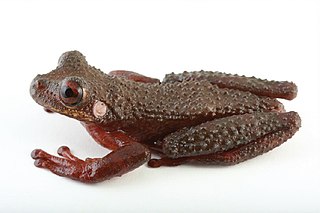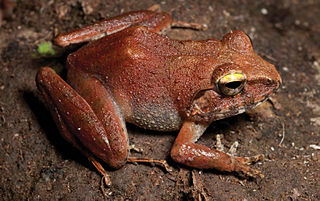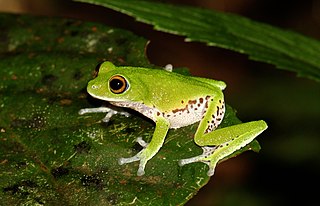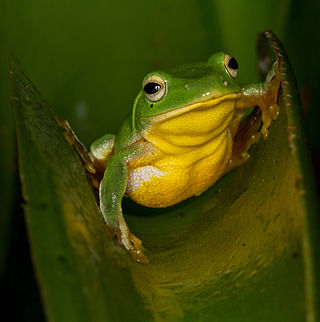The Honduran brook frog is a species of frog in the family Hylidae endemic to Honduras. Its natural habitats are subtropical or tropical moist lowland forests, subtropical or tropical moist montane forests, and rivers. Scientists have seen it between 90 and 1400 m above sea level in Honduras in rainforests.
Hyloscirtus alytolylax, called the babbling stream frog, babbling torrenter, or tadapi tree frog in English, is a species of frog in the family Hylidae found in Colombia and Ecuador. Its natural habitats are subtropical or tropical moist lowland forests, subtropical or tropical moist montane forests, and rivers. It is threatened by habitat loss. Scientists have observed it in Colombia between 500 and 2159 meters above sea level and in Ecuador between 400 and 2000 meters above sea level.
Linda's tree frog is a species of frog in the family Hylidae found in Colombia and Ecuador between 2000 and 2500 meters above sea level. Its natural habitats are subtropical or tropical moist montane forests, rivers, pastureland, rural gardens, and heavily degraded former forests. It is threatened by habitat loss.
The Morona-Santiago tree frog is a species of frog in the family Hylidae endemic to Ecuador. Its natural habitats are subtropical or tropical moist montane forests and rivers. Scientists have seen it between 2225 and 2350 meters above sea level. It is threatened by habitat loss.
The Rio Chingual Valley tree frog is a species of frog in the family Hylidae found in Colombia and Ecuador. Its natural habitats are subtropical or tropical moist montane forests, rivers, and heavily degraded former forests. Scientists have seen it between 1950 and 2700 meters above sea level.
The Pilalo tree frog is a species of frog in the family Hylidae endemic to Ecuador. Its natural habitats are subtropical or tropical moist montane forests and rivers. It has been observed between 2300 and 2600 meters above sea level. It is threatened by habitat loss.
The El Pepino tree frog is a species of frog in the family Hylidae found in Colombia and Ecuador. Its natural habitats are subtropical or tropical moist lowland forests, subtropical or tropical moist montane forests, rivers, and swamps. It is threatened by habitat loss.

The Manaus slender-legged tree frog, also known as the giant broad-headed tree frog, is a species of frog in the family Hylidae found in Bolivia, Brazil, Colombia, Ecuador, French Guiana, Guyana, Peru, Suriname, and Venezuela. Its natural habitats are subtropical or tropical dry forest, subtropical or tropical moist lowland forest, moist savanna, rivers, intermittent freshwater marshes, and canals and ditches. It is threatened by habitat loss. It is also reported to produce Bufotenin.

The Ecuador slender-legged tree frog is a species of frog in the family Hylidae found in Colombia and Ecuador. Its natural habitats are subtropical or tropical moist lowland forests, subtropical or tropical moist montane forests, rivers, intermittent freshwater marshes, rural gardens, and heavily degraded former forests.

Scinax boulengeri is a species of frog in the family Hylidae. It is found in Colombia, Costa Rica, Nicaragua, Panama, and possibly Honduras. Its natural habitats are subtropical or tropical moist lowland forests, intermittent freshwater marshes, pastureland, plantations, rural gardens, and urban areas. It has been found as high as 600 meters above sea level.

Platymantis cagayanensis is a species of frog in the family Ceratobatrachidae. It is endemic to the Philippines, where it is found along the north coast of Luzon Island and on Palaui Island. It has been observed as high as 200 meters above sea level.
Platymantis indeprensus is a species of frogs in the family Ceratobatrachidae.
The Leyte tree frog is a species of frog in the family Rhacophoridae. It is endemic to the Philippines.
Pseudophilautus mittermeieri, commonly known as Mittermeier's shrub frog, is a species of frog in the family Rhacophoridae. It is endemic to Sri Lanka.

Pseudophilautus mooreorum, commonly known as Moore's shrub frog, is a species of frog in the family Rhacophoridae. It is endemic to Sri Lanka.

Pseudophilautus rus, known as Kandian shrub frog is a species of frog in the family Rhacophoridae.

Taruga longinasus is a species of frog in the family Rhacophoridae. It is endemic to Sri Lanka. It has been observed between 150 and 1300 m above sea level.

Leptomantis angulirostris, commonly known as the masked tree frog, is a member of the tree frog family Rhacophoridae and is found in Indonesia and Malaysian Borneo. Its natural habitats are subtropical or tropical moist lowland forests, subtropical or tropical moist montane forests, and rivers. It is threatened by habitat loss.

Zhangixalus arboreus, also known as the forest green tree frog and Kinugasa flying frog, is a species of frog in the family Rhacophoridae endemic to Japan, where it has been observed on Honshu island, as high as 2000 meters above sea level.

The Taipei tree frog is a species of frog in the family Rhacophoridae. It is endemic to central and northern Taiwan. It is a medium-sized tree frog; females are 4.5–5.5 cm (1.8–2.2 in) in snout-vent length, and males are slightly smaller 3.5–4.5 cm (1.4–1.8 in).











